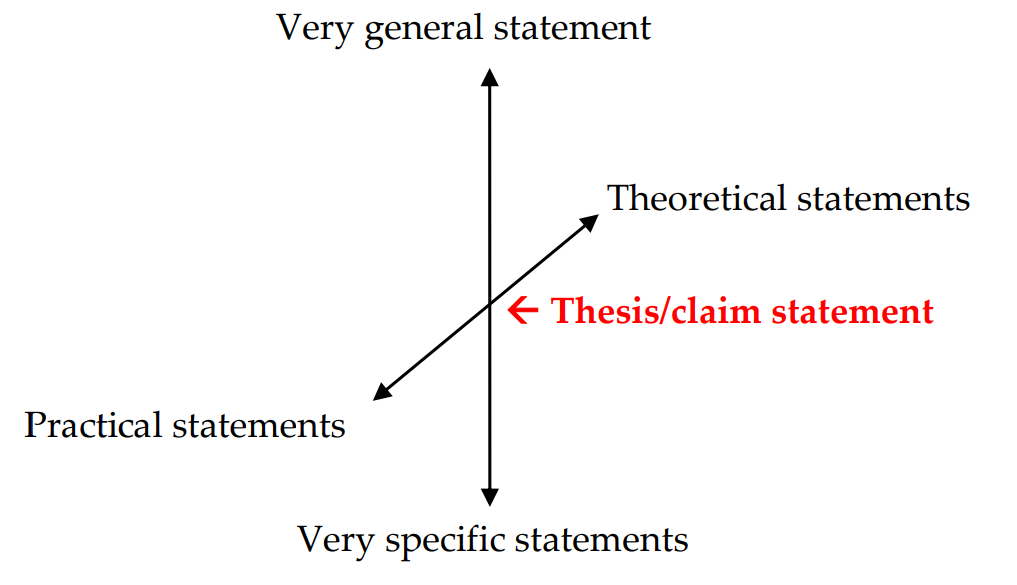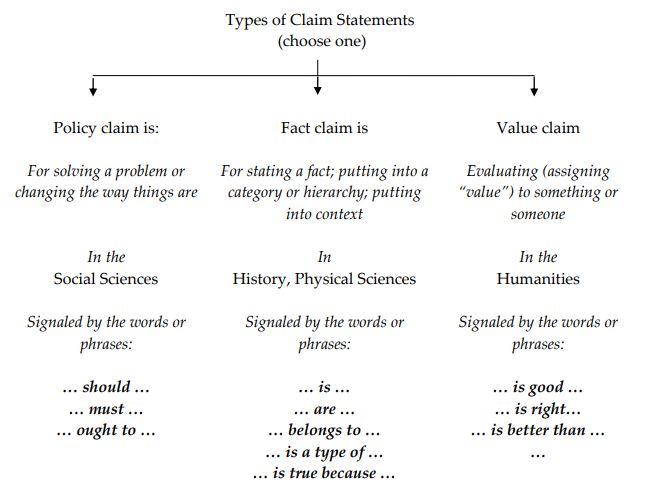2.4: Introduction Paragraph
- Page ID
- 7127
Overview
The Introduction is a more specific summary of your project than the Abstract and contains these kinds of statements:
checklist
1. Draft Checklist
___The summary statement from the end of your Abstract
___Theoretical/rationale statements (reasons why your idea should work, or why we should accept or implement it, why it should be solved, etc.)
___Practical/method statements (steps for how your idea should work, or how we should implement it, how it should be solved, etc.)
___Thesis (a type of claim statement that states a fact to be proved, or calls for some kind of change, or looks at the value you place on the idea or object you are writing about.)
Here is a way to visualize the process of arriving at a thesis/claim statement by writing a Topic Writing, then an Abstract, then an Introduction. We first experiment with different statements on a general-to-specific continuum to reach a summary statement in the Abstract. In the Introduction, we try different statements on a theoretical-to-practical continuum (at the intersection with our summary statement) to reach a thesis/claim statement:

Figure \(\PageIndex{1}\)
Another way to think of the abstract-introduction writing process is like this:
\[\begin{split} \text{Drill-down}\; =\; & \textbf{general}\; statement \\ & \quad \downarrow \\ \text{Abstract}\; =\; & \textbf{general}\; statement\; + \\ & very\; specific\; statements\; + \\ & \textbf{summary}\; statement \\ & \quad \downarrow \\ \text{Introduction}\; =\; & \textbf{summary}\; statement\; + \\ & theoretical\; statements\; + \\ & practical\; statements\; + \\ & \textbf{thesis/claim}\; statement \end{split}\]
Remember, we should change and adjust the answers to the prompts below while we are writing, researching, talking about them, thinking about them, or listening to someone else. In other words, each statement we write is tentative. Each time we change a statement, the final thesis statement will change as well.
To arrive at a thesis/claim statement in a methodical way in writing, we may formulate and reformulate each answer to the following prompts:
Prompts
Write your Introduction by answering the questions below. Think about each one carefully. Then type an answer to the question in a new, blank document. Each answer is a sentence or sentences in your Introduction draft, so indent the first answer and place each of the rest of the answers, one after another, in paragraph form.
checklist
2. Prompts from Draft Checklist
- What is my summary statement from the Abstract?
- In theory, I think my summary statement will work (or should be accepted) because (why?)
- What are some practical steps to implementing my summary statement?
- In other words, how may I restate my summary statement as a thesis or claim?
*Phrases in bold are academic phrases you may use in your draft
If you need help answering these questions, you may use the template below. The template is taken directly from the questions above.
Template
3. Template from Prompts
Introduction
[Insert summary statement from end of Abstract]. In theory, [restate summary] because [why?]. First, [what is a practical first step to implementing claim/proposal?]. Second, [what is a second step?]. Third, [another step?]. In other words, [who?] should [do what to change the way things are?].
*Phrases in bold are academic phrases you may use in your draft
Sample Draft
The draft below is generated from the checklist, prompts, and template above.
4. Draft from Template
Introduction
Some prescription drugs may affect the way adolescents learn how to write academic papers. In theory, some prescription drugs may affect the way adolescents learn how to write academic papers because some of these drugs interrupt or change processing functions in the brain, and writing involves very complex processing skills. First, a doctor must approve the use of any drug in such an experiment as this. Second, a committee should approve the use of human subjects. Third, the writing activity must be a similar as possible for each participant. In other words, teachers should find out how drugs affect the ways student writers process information and adjust teaching strategies accordingly.
*Phrases in bold are academic phrases you may use in your draft
Tutorial
How to answer the prompts
Prompt 1
What is my summary statement (from my Abstract)?
Simply copy the summary statement at the end of your Abstract and make it your first statement in the Introduction.
Prompt 2
Why do I think my summary statement will work (or why should it be accepted)?
What sort of theoretical assumptions support the summary statement you just wrote? “Theoretical” means the theory or theories behind my last statement. It means why it will work or why it should be accepted. Look at your summary statement and ask why (or based on what theory or theories) will it work. You might use a formula similar to this:
Theoretically, [insert summary statement from abstract here] because [insert the reasons you think it will work or should be accepted here].
If that formula seems forced, try listing any theories for key terms in the last sentence. Try asking “What do I have to assume to be true before I can accept this?” or “What do people have to assume to be true before I can accept this?” Begin your first sentence with “Theoretically, …” if you need help getting started.
Copy the main idea from the Abstract summary statement:
Example \(\PageIndex{1}\):
In other words, some prescription drugs may affect the way adolescents learn how to write academic papers.
Ask, “Why…?”
Use pattern from above to insert summary statement and form a theoretical statement:
Example \(\PageIndex{2}\):
Theoretically, some prescription drugs may affect the way adolescents learn how to write academic papers because some of these drugs interrupt or change processing functions in the brain, and writing involves very complex processing skills.
Add at least 2 more theoretical statements (reasons for implementing your summary statement, or reasons to accept your summary statement, or reasons your idea will work, etc.). A good rule-of-thumb for the number of statements we need is 3 to 5. Remember, if you can’t seem to answer this question honestly, you will have to change the answers to the other questions above. Changing them now, however, is much easier, with only a few sentences, than with pages and pages of writing later on.
Prompt 3
What are some practical steps to implementing my summary statement?
These practical statements outline as simply as possible the practical steps that must be taken in order to accept your summary statement or solve your problem or achieve some outcome. “Practical” here means what actions a single person must take. If a statement such as the following is part of your practical statements, then it is not very practical: “First we must change the laws in this state.” Many other steps must be taken before a law is changed. If you really do want to change the laws, ask yourself what the first thing YOU will do to change the laws. Call a legislator? Write a letter? Read more about it? Write a petition to pass around? Once you determine where to start, what is the next step? And so on. From the short list above, the simplest task sounds like writing a letter. If so, I will then simply list the steps I must take in writing the letter.
Note
This series of steps should be one a reader can actually follow as an individual; it should really be “do-able.” If my project needs a methodology, this is where I put it, or at least introduce it.
“Method” or “practical steps” or “process” towards implementing your summary statement may be indicated in writing as simply as First … Second … Third… :
Example \(\PageIndex{3}\):
First, a doctor must approve the use of any drug in such an experiment as this. Second, a committee should approve the use of human subjects. Third, the writing activity must be a similar as possible for each participant.
Or by which steps we are taking:
Example \(\PageIndex{4}\):
Step one, a doctor must approve the use of any drug in such an experiment as this. For the next step, a committee should approve the use of human subjects. For step three, the writing activity must be as similar as possible for each participant.
And so on. Note that in both examples, the transition phrases may be left out and the reader still understands that these are method or practical or process statements.
A good rule-of-thumb for the number of statements we need is 3 to 5.
Prompt 4
How may I restate my summary statement as a claim?
A “claim” is a statement that one has to prove, either by argument, testimony, or other evidence. The language or words we use in the claim statement will determine, to some extent, how we go about finding and using “proof.” Note that the claim for any particular reading may contain a combination of types below, but there is usually a primary type of claim (as indicated by the words in bold).

Figure \(\PageIndex{1}\)
A “policy” claim
A policy claim is a statement that claims or implies that some action should be taken or avoided. In other words, state your issue in a way that calls for some kind of change. Examples:
Example \(\PageIndex{5}\):
We must stand up for our rights. (We don’t at the moment):
___________ must ______________.
Readers should read literature from multiple perspectives. (We don’t at the moment):
___________ should _____________.
Teachers should teach students that essays are made up of elements. (We don’t at the moment):
___________ should _____________.
If you are proposing a solution to a problem, it is still considered a policy claim. You may put it in one of the formats above, or you might simply use this format:
Example \(\PageIndex{6}\):
I propose that writing teachers focus more on patterns and less on grammar.
A “fact” claim
This is a statement that states a fact to be proved or disproved. For example:
Example \(\PageIndex{7}\):
Teenagers are bad drivers.
A fact claim sometime categorizes an object of study:
Example \(\PageIndex{8}\):
Sausage is a type of meat.
A “value” claim
A value claim evaluates or assigns value to something:
Example \(\PageIndex{9}\):
It is wrong to attack before the government explores all diplomatic possibilities.
The best way to drive is 5 mph below the posted speed limit.
Restate your summary statement above (the answer to the “How may I summarize…” question) using the key phrases in bold above to experiment with the thesis as a claim.
I am going with a policy claim:
Teachers should find out how drugs affect the ways student writers process information and adjust teaching strategies accordingly.
Most Common Question: “After this introduction, what is all the rest of the paper about?”
The last statement of your introduction is also your claim statement. Every other question in your essay will be directed to this statement. In other words, when you go to the next set of questions, each question will be asked of your claim statement


